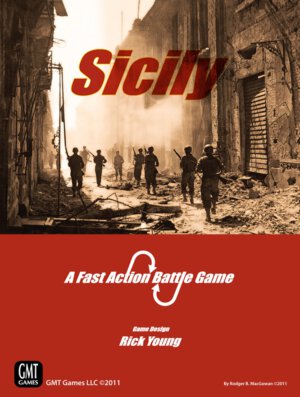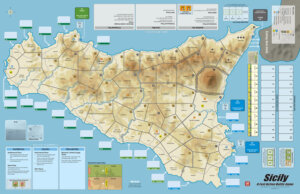
Publisher: GMT Games
Designer: Rick Young
Artists: Knut Grünitz, Rodger B. MacGowan, and Mark Simonitch
Year: 2011
Players: Two players
Ages: 13+
Playing Time: One to three and a half hours
Genre: Fog of war block WWII game
MSRP: $60.00
Fast Action Battles: Sicily (FABS) is the second title in the FAB series from designer Rick Young and covers the Allied invasion of Sicily in 1943. The series is meant to be a lower complexity wargame for the masses as opposed to one that strictly appeals to the grognard crowd. This being said, don’t be fooled by the title Fast Action Battles because this is not going to be a game you bust out with a friend who somehow thinks something along the lines of Memoir ’44 or Axis and Allies is a medium complexity wargame. I’m not trying to dissuade anyone from buying FAB: Sicily but it’s important to note that for the average wargamer the complexity may be on the lower end of the scale but for your average overall gamer it will be toward the higher end – at least to begin with.
FABS is a fog of war block game in which each unit is a small wooden block with a sticker on one side viewable to the player controlling those forces while the other side of the block is blank. Columbia Games has built their company on titles of this sort and I happen to be a fan of them. The Commands and Colours line from GMT (another excellent system I must say) also utilizes a form of this block system. FABS pumps this up a bit because not only do you have your block units but also various counters that represent different assets that become available to you. These counters can represent anything from naval bombardments, ranger units, armor, engineers, even fuel or command staff depending on the scenario being played.

FABS is turn based and the Allies always go first followed by the Axis. Each player will receive reinforcements and assets at the beginning of the turn and then the Allies will move operationally, move units strategically (those that are designated as reserve units), enter combat, allow the axis to react with their own strategic movement, move units that have broken through, resolve break through combat, and then check for supply. The Axis player then takes their turn and once that is finished a victory check is made to see if either force has won. If victory hasn’t been achieved it’s on to the next turn. All of this is old hat as an I go/You go style of gameplay. This does lead to a bit of down time but this a pretty traditional approach and, since this is a two player game, if you can’t be bothered to pay attention to your opponent you might just want to settle in on the couch with your Wii controller in hand…
Most of this is pretty straight forward although combat resolution has a variety of steps to resolve and damage determination can be a bit tricky. In most block games each force has a certain level that is displayed at the top of the block. As losses are taken the block is rotated to indicate the reduced strength, or what is sometimes called a step reduction. When reinforcements are applied to that unit the block is rotated again to indicate the reinforced strength. All in all it’s a fairly simple procedure. In FABS damage resolution plays a bit differently as the attacker can abort an attack, the defender can reduce hits taken by removing defensive works, or can simply retreat among other ways to avoid taking that step reduction. This might take a bit for someone to get their head around as it’s radically different than what one normally encounters in a block based wargame.
The system does work and, although it’s a bit off the wall in some ways, you can come to grips with it within a couple of turns. Which leads to the “fiddly” conversation as Fast Action Battles Bulge (the first game in the series) had the unofficial moniker of Fiddly Action Battles. Not having played FABB I can’t speak to that title’s criticism but it appears to me that the same holds true with FABS as well; there are a lot of situational exceptions one has to refer to from time to time and the way the rules are originally presented you’ll spend quite a bit of time flipping through the book to find what you’re looking for. I can say that GMT did produce a new rule book as part of their Living Rules section for FABS in mid-January and the new book is a great help. Also the Play Book is almost completely made up of examples of play so that comes as a tremendous asset as well in learning the game. With a few game plays under your belt you won’t need to refer to either book too often.
You’ll also find an introductory map and scenario in which to get your feet wet before you tackle the larger scenarios.

As the Axis player you have to continually use the Sicilian terrain to your advantage while you delay the Allied advance. Keeping in mind the Italian morale continues to degrade, unless the Allied player is completely screwing the pooch, the Axis have to continually pull back to shorten their lines while doing their best to hold onto critical map objectives. Opportunities for counter thrusts will usually appear and these have to be jumped on immediately. German units also have to be taken advantage of and not using them effectively will spell doom for the Axis player.
The Allies might have an easier time but they still have to deal with the difficult terrain as they do their best to stretch the defenders as thin as possible. Not using special assets at the right time to circumvent defenses can leave the Allies in a pinch while not securing airfields leaves the Luftwaffe available to negate gaining air superiority. The Allied player needs to focus on making flanking beach landings to cut off Axis routes of retreat as well while insuring units aren’t vulnerable to counter attacks due to over confidence.
The bottom line is I certainly recommend FABS, although probably not as an introduction to wargaming as some may suggest. I feel it’s a great title for someone who already has a few fairly basic wargames under their belt or for those who don’t expect a rulebook to be five pages in length. For those out there who are veteran wargamers this is still a great title since there’s a lot more meat to the system than that normally found in a fog of war block game. The situation is one that games out with a historic feel to the results whatever they may happen to be in any given game play and the map is laid out, and the victory conditions set, fighting will rage all across Sicily as opposed to units just all stacking up on one spot on the board. Both combatants have interesting challenges they have to face and a complete game can easily be finished within three and a half hours or so once you have the rules under your belt.
[rwp-review id=”0″]
- Pinebox, TX Middle School Boxed Set Reviewed - Dec 24, 2024
- Score Big Savings with the Fifty-Dungeon Bundle of Holding - Dec 24, 2024
- The ACKS II Revised Rulebook Lands in PDF - Dec 24, 2024



















“Not for beginners in my opinion”
What would be a good game for beginners?
I’d say if someone were new to wargames, and were interested in checking out how a fog of war block game could operate, any of the Columbia block games are a great start or even the Command and Colours line from GMT. Anyone with a few wargames under their belt shouldn’t have any issues with FAB though.